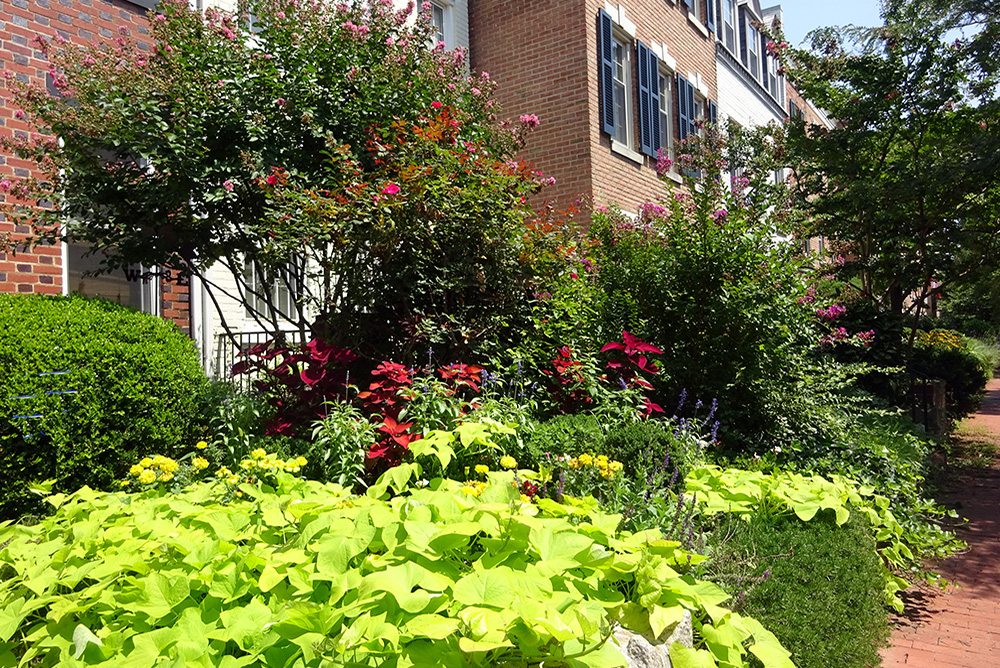
Above and on the front, a little Capitol Hill front yard that is chockablock with seasonal color. The crape myrtle trees along the right side form a living fence. / Photos by Stephanie Cavanaugh.
THERE’S A LITTLE row house in Washington DC’s Capitol Hill neighborhood that I pass almost daily in my tromp back and forth to the market or for coffee or a cookie or some such procrastination.
It appears firmly set apart from the adjacent property, even though they’re in fact divided by nothing more than a surveyor’s measure. It’s an effect worth examining, particularly if you don’t like your neighbors—or wish to protect your turf from the clomping hooves of the postal persons, trampling a path through your front yard.
The trick is in shaping the patch of garden. This one is maybe eight feet square (measuring with my size 8 feet plus a smidge) and sits well above the sidewalk, bordered by a concrete walk on the left side, leading to the front porch steps. On the right, from the porch to where the garden meets the street, is a graceful curve of crape myrtles.*
At the top, butting up against the porch railing, is a watermelon-pink crape myrtle, which has reached a fine height and healthy girth. Smooshed in front of it is a smaller tree, tending toward cerise. On the downward slope of the property line, a third tree is more purple than pink and lower to the ground. The trio forms a candy-colored froth of flowers, and an impenetrable screen between the houses.**
A fine, big old boxwood, as healthy a one as I’ve ever seen, is directly in front of the house. Trimmed to the height of the porch rail, it allows one to sit with one’s martini in privacy— yet snoop over its tightly budded crown at passersby.
Just above the sidewalk, a stone retaining wall drips with creeping phlox, purple-flowering in spring, thick and green the rest of the year.
Such trees and perennials create the garden’s frame; within it the plants change with the seasons.
Now, in mid-August, red coleus provides a high-frilled backdrop for scattered plops of yellow marigolds, sprigs of purple sage, a couple of pinkish geraniums and a clump or two of basil. So densely packed are the plants, no staking is necessary.
Along the front, a sweet-potato vine frolics over the edge of the garden wall, onto the walkway and ruffles down the steps to the sidewalk. Some might say it’s a little excessive, but I say go big or go home.
Soon enough, the garden will move into fall mode, with pansies and ornamental cabbages replacing the summer annuals. Perhaps a chrysanthemum will crowd its way in. Underneath, spring bulbs will rest, poking up as the winter begins its gradual return to summer, a gaiety of crocus, grape hyacinth and tulips springing up behind that front flounce of purple phlox.
(Don’t worry about under-planting bulbs in the garden, by the way. They wriggle around whatever’s above them, figuring their way up to the light.)
It’s such a neat little plot, so manageable, tamed yet effervescent, always brimming with color and life, even as most gardens hunker down beneath a wintry shroud.
You’ll notice that none of the plants and flowers and bulbs used here is exotic. Even if you can hardly tell garden shears from hedge clippers, you can probably identify most of them; people with the need to impress can bandy about the Latin names, like tagetes erecta instead of marigold.
As with cooking, one can double or triple and so forth the recipe, adding more bushes and trees to semi-encircle the plot, leaving the center for flowers and shrubs—and maybe a fountain. Perhaps a sculpture?
Of course, one doubles and triples the expense and the labor as the garden grows. The brain can also blow up with the expanded possibilities, which is why this concise space has such appeal. If a plant goes belly-up, replacing it is hardly an ordeal.
—Stephanie Cavanaugh
*Though slow to leaf out and flower, among the last trees to do so each year (which can be a tad depressing when you’re longing for full-blown summer), crape myrtles have a bark that is interesting, and the lengthy, constant floral display once they get going is eye-popping.
** The first crape myrtle seems squeezed too tightly against the front porch, and some year soon it may require a pretty severe pruning, if not a painful (and painfully expensive) extraction.
LittleBird “Stephanie Gardens” finds garden inspiration wherever she goes.

Lovely to look at….enjoyed this one…thanks for sharing…